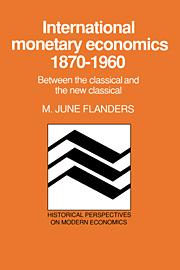2 - The classical mainstream and the nineteenth-century monetary controversies
Published online by Cambridge University Press: 12 October 2009
Summary
A brief summary of the highlights of the nineteenth century will serve as a background to later developments. I draw heavily on secondary sources, Fetter (1965), O'Brien (in his fascinating introduction to The correspondence of Lord Overstone, 1971: 70–82) and Viner (1937). The first two do not concentrate specifically on international considerations, but then the early monetary discussions distinguished less than did later ones between closed and open economy analysis. This justifies the muted distinction made by writers such as Fetter and O'Brien (and even, to a certain extent, Viner). I can think of several reasons for this:
The openness of the British economy, which led naturally to the assumption that one was dealing with an open economy model. By contrast, the American economy (whence much of the later discussion issued) was, at least until recently, relatively closed.
The institutional differences: throughout most of the nineteenth century, a metallic standard meant that bank notes were convertible into gold (and/or silver) at will, whether internally or externally. Thus, issues of the integrity and convertibility (into metal) of the liabilities of either the central or private banks were essentially independent of who was demanding the specie or bullion and what they planned to do with it. Bagehot indeed did distinguish between internal and external drains, but this came later, towards the end of the nineteenth century.
Most of the literature I shall deal with here is British.
- Type
- Chapter
- Information
- International Monetary Economics, 1870–1960Between the Classical and the New Classical, pp. 26 - 46Publisher: Cambridge University PressPrint publication year: 1990

